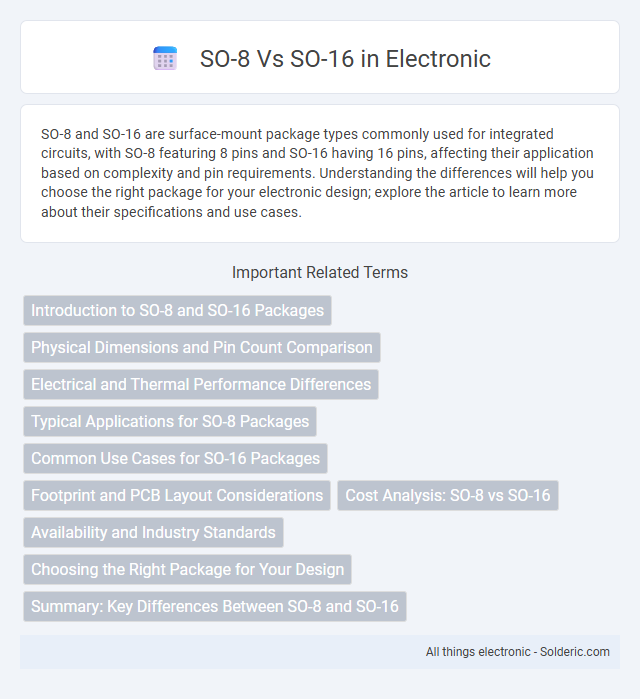SO-8 and SO-16 are surface-mount package types commonly used for integrated circuits, with SO-8 featuring 8 pins and SO-16 having 16 pins, affecting their application based on complexity and pin requirements. Understanding the differences will help you choose the right package for your electronic design; explore the article to learn more about their specifications and use cases.
Comparison Table
| Feature | SO-8 | SO-16 |
|---|---|---|
| Number of Pins | 8 | 16 |
| Package Type | Small Outline Integrated Circuit (SOIC) | Small Outline Integrated Circuit (SOIC) |
| Pin Pitch | 1.27 mm (typical) | 1.27 mm (typical) |
| Body Width | 3.9 mm (approx.) | 7.5 mm (approx.) |
| Typical Applications | Low to medium pin count ICs like op-amps, voltage regulators | Higher pin count ICs such as multiplexers, microcontrollers |
| Thermal Performance | Moderate heat dissipation capability | Improved heat dissipation due to larger size |
| Mounting | Surface-mount technology (SMT) | Surface-mount technology (SMT) |
Introduction to SO-8 and SO-16 Packages
SO-8 and SO-16 are standard small outline integrated circuit packages widely used in electronics for surface mounting on printed circuit boards (PCBs). The SO-8 package features 8 pins arranged in a compact form factor, making it ideal for applications requiring fewer connections and reduced footprint. In contrast, the SO-16 package doubles the pin count to 16, offering increased functionality and connectivity options suited for more complex circuits while maintaining similar mounting advantages.
Physical Dimensions and Pin Count Comparison
SO-8 packages typically measure around 5.0 mm by 6.2 mm with 8 pins, while SO-16 packages are larger, approximately 7.5 mm by 10.3 mm, providing 16 pins for increased connectivity. The difference in pin count directly influences the physical size, making SO-16 suitable for more complex circuits requiring additional connections. Choosing the right package depends on your design requirements for space efficiency and the number of electrical connections needed.
Electrical and Thermal Performance Differences
SO-8 packages typically exhibit lower thermal resistance than SO-16 packages due to their smaller die size and reduced pin count, enabling more efficient heat dissipation for lower power applications. Electrical performance in SO-8 is often optimized for simpler circuits with less parasitic capacitance and inductance, whereas SO-16 supports higher pin density, allowing for more complex connectivity but potentially increased signal crosstalk and power consumption. Thermal and electrical trade-offs between the two impact device selection, with SO-8 favoring compact, low-power designs and SO-16 suited for multi-channel or higher functionality integrated circuits.
Typical Applications for SO-8 Packages
SO-8 packages are commonly used in applications requiring compact, low-pin-count ICs such as operational amplifiers, voltage regulators, and small microcontrollers. Their smaller footprint optimizes space in consumer electronics, power management modules, and sensor interfaces. You will find SO-8 packages ideal for designs where efficient thermal performance and ease of PCB layout are critical.
Common Use Cases for SO-16 Packages
SO-16 packages are widely used in applications requiring higher pin counts, such as dual operational amplifiers, bus transceivers, and quad comparators, making them ideal for complex integrated circuits. Their compact design facilitates efficient space utilization on PCBs, especially in telecommunications, automotive, and consumer electronics where multiple signal paths are necessary. SO-16's enhanced pin configuration supports comprehensive functionality in power management and sensor interfaces compared to the simpler SO-8 package.
Footprint and PCB Layout Considerations
SO-8 packages have a smaller footprint with 8 pins arranged in two rows, requiring less PCB space and enabling higher circuit density compared to SO-16, which has 16 pins and a wider layout. The increased pin count of SO-16 demands more complex PCB routing and larger board area, impacting design constraints and potential signal integrity. Careful consideration of trace spacing, pad size, and thermal management is essential when transitioning between SO-8 and SO-16 footprints to ensure reliable performance and manufacturability.
Cost Analysis: SO-8 vs SO-16
SO-8 packages generally offer lower costs due to smaller size, reduced material use, and simpler manufacturing processes, making them ideal for budget-sensitive applications. SO-16 packages, while more expensive, provide increased pin count essential for complex circuits requiring higher I/O capabilities, justifying the cost in advanced designs. Cost analysis must consider volume, application requirements, and PCB layout constraints to determine the most cost-effective option between SO-8 and SO-16.
Availability and Industry Standards
SO-8 packages are widely available and conform to established industry standards, making them a popular choice for integrated circuits with lower pin counts. SO-16 packages offer greater pin density while maintaining compatibility with standard manufacturing processes and design guidelines, increasing their adoption in applications requiring more complex connectivity. Both package types are supported by major semiconductor manufacturers and comply with JEDEC standards, ensuring broad availability and reliable integration in various electronic devices.
Choosing the Right Package for Your Design
Selecting between SO-8 and SO-16 packages depends on the required pin count and circuit complexity; SO-8 suits simpler designs with fewer connections, while SO-16 accommodates more complex circuits needing additional pins. Thermal performance and PCB space are critical factors; SO-16 offers better heat dissipation and more routing options but consumes more board area. Evaluating signal integrity requirements and component availability ensures optimal integration and reliability within your electronic design.
Summary: Key Differences Between SO-8 and SO-16
SO-8 and SO-16 are surface-mount IC package types distinguished primarily by the number of pins, with SO-8 having 8 pins and SO-16 featuring 16 pins, impacting their complexity and connection capabilities. SO-16 supports more complex circuits and higher functionality due to its increased pin count, making it suitable for applications requiring additional input/output options. Your choice between SO-8 and SO-16 should depend on the component pin requirements and the circuit design specifications.
SO-8 vs SO-16 Infographic

 solderic.com
solderic.com